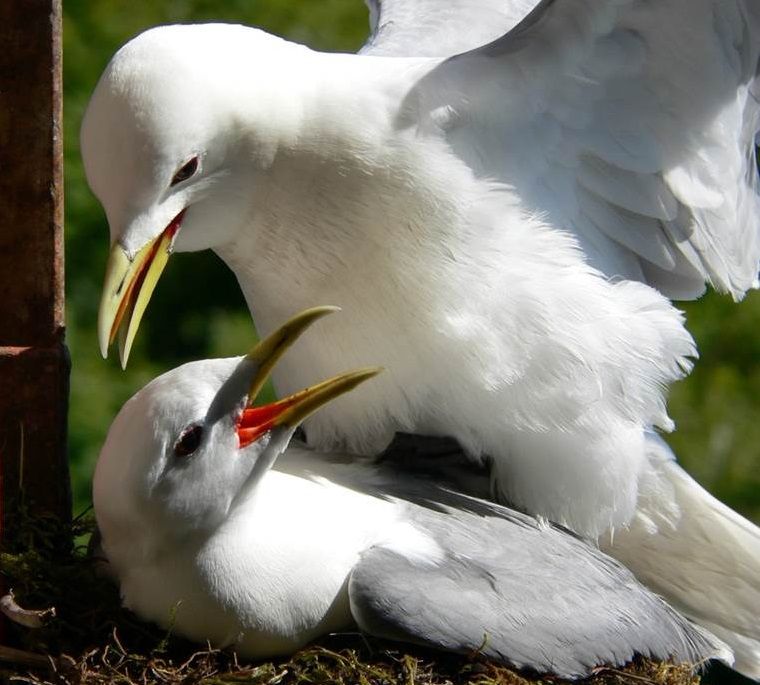
Researchers have demonstrated the first experimental evidence of an infection being transmitted sexually in a wild population of animals, according to a study published in The Biological Journal of the Linnean Society.
Previously, scientists had experimentally confirmed such infections in several domestic species and captive animals. However, experimental proof of sexually transmitted infections, or STIs, in wild populations has not been easy to come by. This lack of knowledge is concerning given that STIs in animals "may have profound eco-evolutionary consequences," the authors wrote in the study.
To demonstrate the sexual transmission of an infection in wild animals, a team including scientists from the Veterinary Medicine University Vienna and the University of Toulouse, France, artificially blocked the transfer of sperm in a group of seagulls.
First, they captured 70 male-female pairs of the seabirds—known as black-legged kittiwakes—from a wild colony in Alaska and took bacterial samples from their posterior orifice, known as a cloaca. They then fitted 33 of the males with a special ring that prevented them from inseminating females. Meanwhile, the remaining males were fitted with a control device that permitted insemination.
After this, the birds mated. When the females laid their first egg, the scientists took another bacterial sample.
"For the males in the experimental group, the simple plastic ring, which we had developed in a previous study, works much like a male chastity belt by blocking inseminations," Richard Wagner, an author of the study, said in a statement. "Certain explanations can be ruled out by comparing the cloacal bacteria samples taken before and after the ring's application between the experimental and the control group."
"Pathogenic bacterial strains that are found after mating in both sexes in the control group, but only among males in the experimental group, are an indication of sexual transmission," he said. "For example, if a male has strains X, Y and Z and his mate has Z only, we would find that after we blocked insemination, the female would lose strain Z. This means that the female had acquired strain Z from the male through copulation and was able to rid herself of it, given a lack of further inseminations."
Using this experimental setup, the scientists were able to identify the transmission of a bacteria known as Corynebacterium, strains of which can cause certain diseases in humans, such as diphtheria.
"STIs have been identified in several wild animal species, but to our knowledge this study is the first to experimentally manipulate sperm transfer in a natural population of animals to demonstrate sexual transfer," Wagner told Newsweek.
The team then investigated the impact of the sexually transmitted infection on the female birds, finding that it reduced fertility.
"Infected females achieved the same reproductive success as uninfected females, but they laid their eggs earlier and produced a higher clutch size," said Wagner. "This suggests that females pursued a costly strategy of compensation that made up for the disadvantage of infection."
According to the team, the increased stress on the reproductive system of the birds as a result of the infection could have implications for the evolution of defensive measures in females over time.
"Our results provide new insights into the fitness consequences of STIs in a wild species and may stimulate further research on their evolutionary implications," the authors wrote in the study.
"We hope our study, which demonstrates the feasibility of researching STIs in nature, will stimulate further research," Wagner said.
He added that the latest study marks the beginnings of a new avenue of research for scientists, which could have several other important implications.
"We are at the early pioneering stage of a potential new and exciting field," Wagner said. "As ecologists, we study how selection shapes behavioral, morphological and physiological adaptations. Our study has implications for numerous branches of pure science, such as microbiology, genetics and physiology.
"The same mechanisms that transmit bacteria may also transmit viruses, potentially including West Nile virus, avian flu and swine flu, providing implications for applied, as well as pure, science," he said. "The study of avian disease transmission is also applicable to conservation and biodiversity in that sexual diseases may further threaten endangered populations."
This article was updated to include additional comments from Richard Wagner.
Uncommon Knowledge
Newsweek is committed to challenging conventional wisdom and finding connections in the search for common ground.
Newsweek is committed to challenging conventional wisdom and finding connections in the search for common ground.
About the writer
Aristos is a Newsweek science reporter with the London, U.K., bureau. He reports on science and health topics, including; animal, ... Read more
To read how Newsweek uses AI as a newsroom tool, Click here.








